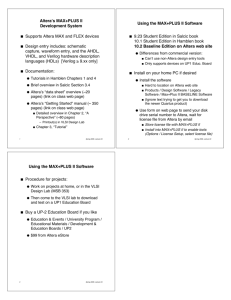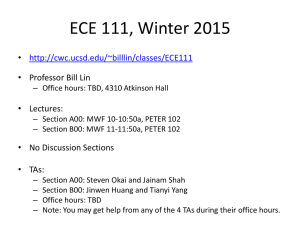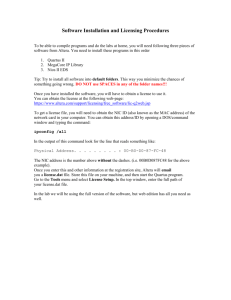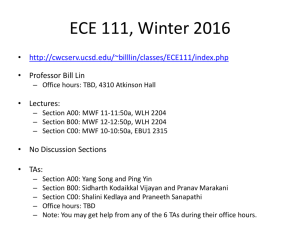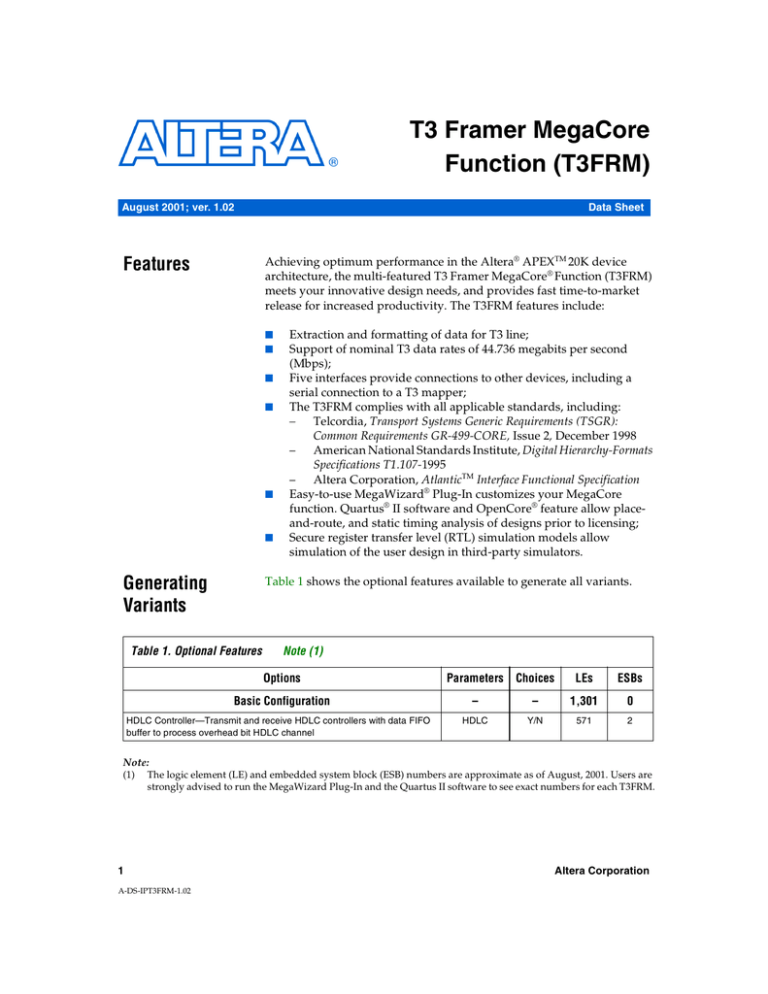
T3 Framer MegaCore
Function (T3FRM)
August 2001; ver. 1.02
Data Sheet
Achieving optimum performance in the Altera® APEXTM 20K device
architecture, the multi-featured T3 Framer MegaCore® Function (T3FRM)
meets your innovative design needs, and provides fast time-to-market
release for increased productivity. The T3FRM features include:
Features
■
■
■
■
■
■
Generating
Variants
Extraction and formatting of data for T3 line;
Support of nominal T3 data rates of 44.736 megabits per second
(Mbps);
Five interfaces provide connections to other devices, including a
serial connection to a T3 mapper;
The T3FRM complies with all applicable standards, including:
–
Telcordia, Transport Systems Generic Requirements (TSGR):
Common Requirements GR-499-CORE, Issue 2, December 1998
–
American National Standards Institute, Digital Hierarchy-Formats
Specifications T1.107-1995
–
Altera Corporation, AtlanticTM Interface Functional Specification
Easy-to-use MegaWizard® Plug-In customizes your MegaCore
function. Quartus® II software and OpenCore® feature allow placeand-route, and static timing analysis of designs prior to licensing;
Secure register transfer level (RTL) simulation models allow
simulation of the user design in third-party simulators.
Table 1 shows the optional features available to generate all variants.
Table 1. Optional Features
Note (1)
Options
Parameters
Choices
LEs
ESBs
Basic Configuration
–
–
1,301
0
HDLC
Y/N
571
2
HDLC Controller—Transmit and receive HDLC controllers with data FIFO
buffer to process overhead bit HDLC channel
Note:
(1)
The logic element (LE) and embedded system block (ESB) numbers are approximate as of August, 2001. Users are
strongly advised to run the MegaWizard Plug-In and the Quartus II software to see exact numbers for each T3FRM.
1
A-DS-IPT3FRM-1.02
Altera Corporation
T3 Framer MegaCore Function (T3FRM) Data Sheet
Typical
Applications
Figure 1 shows the T3FRM connecting to different Altera MegaCore
functions.These three examples show the T3FRM acting as a Midbus
master. See “Interfaces & Protocols” on page 4 for more information about
the Midbus interface.
Figure 1. T3FRM as a Midbus Master
T3 Line Interface
Midbus Interface
Atlantic Interface
T3 Line
T3 Line
T3 Framer
(T3FRM)
T3 Framer
(T3FRM)
Cell Processor
(CP155)
ATM (1)
PLCP (2)
Mapper
Midbus Interface
Atlantic Interface
Cell Processor
(CP155)
ATM
Atlantic Interface
T3 Line
T3 Framer
(T3FRM)
Packet Processor
(PP155)
Packet Data
Notes
(1)
(2)
ATM—Asynchronous Transfer Mode
PLCP—Physical Layer Conversion Protocol
Figure 2 illustrates the T3FRM acting as a T3 Line interface slave.The T3
Mapper MegaCore Function (T3MAP), and SONET STS-1 Framer
MegaCore Function (STS1FRM) are also shown.
Figure 2. T3FRM as Line Interface Slave
Midbus Interface
Line
Interface
Circuit
Altera Corporation
SONET STS-1 Framer
(STS1FRM)
T3 Mapper Interface
T3 Mapper
(T3MAP)
T3 Line Interface
T3 Framer
(T3FRM)
T3 Line
2
T3 Framer MegaCore Function (T3FRM) Data Sheet
Functional
Description
The T3FRM supports unchannelized digital signal level 3 (DS3)
applications with C-bit parity functions and specialized multiplex 23
(M23) applications. It comprises two sub-blocks, the receive framer
(RXFRMR), and the transmit framer (TXFRMR), illustrated in Figure 3.
The following list of functions is based on a full-feature T3FRM.
RXFRMR
■
■
■
■
■
■
■
■
■
■
Sends payload data to various blocks
Provides frame synchronization for:
–
Unchannelized C-bit parity applications
–
Specialized unchannelized M23 applications
Bipolar Three Zero Substitution (B3ZS) Decoding
Provides high-level data link control (HDLC) to terminate the path
maintenance data link and accumulate data in a first in first out
(FIFO) buffer
Processes HDLC and link access protocol D (LAPD) frames
Provides alarm detection
Monitors performance using interval counters to accumulate: line
code violations (LCV), far end block error (FEBE) events, alarm
indication signals (AIS), loss of signal (LOS), excessive zeroes (EXZ),
P-bit parity errors, C-bit parity errors, out of frame (OOF) errors
Detects far end alarm and control (FEAC) codes
Extracts overhead bits to a serial hardware interface
Detects pseudo random bit sequence (PRBS)
TXFRMR
■
■
■
■
■
■
■
■
■
■
3
Receives payload data from various blocks
Constructs frame for:
–
Unchannelized C-bit parity applications
–
Specialized unchannelized M23 applications
B3ZS Encoding
Provides HDLC to insert data to the path maintenance data link
channel with a data FIFO buffer
Generates HDLC and LAPD frames
Inserts FEAC code
Inserts overhead bits from a serial hardware interface
Provides diagnostic insertion of alarm and error signals
Generates PRBS
Provides software control of C-bits
While T3FRM provides transparent transmission of M23 frames,
it does not handle digital signal level 2 (DS2) multiplexing, or bit
stuffing.
Altera Corporation
T3 Framer MegaCore Function (T3FRM) Data Sheet
Interfaces &
Protocols
Five interfaces, illustrated in Figure 3, support the T3FRM.
Midbus Interface
The Midbus is a simple synchronous full-duplex data path bus. The
T3FRM Midbus runs at 44.736 MHz over a single byte lane in each
direction. In the receive (RX) direction, data is transferred from the
Midbus master, RXFRMR, to the slave. In the transmit (TX) direction, data
is transferred from the slave to the master, TXFRMR. In each direction, the
Midbus can carry eight bits per clock cycle. It includes Midbus receive
data (mrxdat[7:0]) and Midbus receive enable (mrxena) lines to
indicate valid data transfers in the receive direction, and Midbus transmit
data (mtxdat[7:0]) and Midbus transmit enable (mtxena) lines to
indicate valid data requests in the transmit direction.
AIRbus Interface
Using a simple synchronous internal processor bus protocol, the AIRbus
provides access to internal registers. This protocol consists of separate
read (rdata) and write (wdata) data buses, a data transfer acknowledge
(dtack) signal, and a select (sel) signal. An address bus (addr[6:1])
and read (read) signal indicate the location and type of access within the
block. The rdata buses and dtack signals can be merged from multiple
blocks using a simple OR function. The dtack signal is sustained until the
block sel is removed (four-way handshaking) meaning the AIRbus can
cross clock domain boundaries. The T3FRM is an AIRbus slave with a data
width of 16 bits.
T3 Mapper Interface
The T3 Mapper interface offers an optional serial connection to a T3
mapper. The DS3 bit stream, including the overhead bits, is mapped into
the SONET STS-1 synchronous payload envelope (SPE), asynchronously.
T3 Line Interface
The T3 Line interface sends and receives DS3 signals at a data rate of
44.736 Mbps and acts as a T3FRM master. This interface provides a
connection to a transceiver. In the transmit direction it converts encoded
digital signals into pulses for transmission over cable, and vice versa in the
receive direction. The T3FRM is a T3 Line interface slave.
Altera Corporation
4
T3 Framer MegaCore Function (T3FRM) Data Sheet
T3 Overhead Interface
As a serial hardware interface, the T3 Overhead interface, provides proper
clocking and framing of the overhead bit stream for the insertion and
extraction of overhead bits.
Figure 3 illustrates the T3FRM divided into RXFRMR and TXFRMR,
including the five interfaces.
Figure 3. Block Diagram
rxreset_n
rxsclk
RXFRMR
rxbit
T3 Mapper
Interface
rclk
T3 Line
Interface
rohclk
rpdata
rohfp
rndata (2)
roh
T3 Overhead
Interface
lcv (2)
mrxclk
mrxena
mrxffp
mrxefp
mrxfoh
mrxval
mrxdat[7:0]
alos
Midbus Interface
RCLK DOMAIN
CLK44 DOMAIN
read
sel
txreset_n
clk44
wdata[15:0]
addr[6:1]
rdata[15:0]
AIRbus
Interface (1)
dtack
irq
tclk
T3 Line
Interface
tpdata
tndata (3)
tfp (3)
TXFRMR
mtxclk
mtxena
mtxffp
mtxefp
mtxfoh
mtxval
mtxdat[7:0]
Midbus Interface
tohclk
tohfp
toh
T3 Overhead
Interface
tohins
txsclk
txbit
T3 Mapper
Interface
Notes:
(1)
(2)
(3)
5
The AIRbus interface provides access to internal registers for the entire block.
lcv and rndata are one pin.
tfp and tndata are one pin.
Altera Corporation
T3 Framer MegaCore Function (T3FRM) Data Sheet
I/O Signals
The following is a list of input/output signals, for the T3FRM. The signal
direction is indicated by (I) for input and (O) for output.
RCLK Domain: T3 Line Interface Signals: rclk (I), rpdata (I), rndata
or lcv (I); T3 Mapper Interface Signals: rxsclk (O), rxbit (O); T3
Overhead Interface Signals: rohclk (O), rohfp (O), roh (O): Midbus
Signals: mrxffp (O), mrxefp (O), mrxfoh (O), mrxdat[7:0] (O),
mrxclk (O), mrxval (O), mrxena (O).
CLK44 Domain: clk44 (I), T3 Line Interface Signals: tclk (O), tpdata
(O), tndata or tfp (O); T3 Mapper Interface Signals: txsclk (O),
txbit (I); T3 Overhead Interface Signals: tohclk (O), tohfp (O), toh
(I), tohins (I); Midbus Signals: mtxffp (O), mtxefp (O), mtxfoh (O),
mtxdat[7:0] (I), mtxclk (O), mtxval (O), mtxena (O). AIRbus
Signals: read (I), sel (I), wdata[15:0] (I), addr[6:1] (I), rdata
[15:0] (O), dtack (O), irq (O).
Maintenance Signals: rxreset_n (I), txreset_n (I).
Test Signal: alos (I).
Performance
Table 2 shows the required speed and estimated gate count of the T3FRM
in an APEX 20K device.
Table 2. Performance
Note (1)
LEs
ESBs
fMAX (MHz)
1,301 – 1,872
0–2
44.736 is required
Note:
(1)
Licensing
All LE and ESB numbers are approximate as of August 2001. They reflect the range
from the basic to full feature variant.
A license is not required to perform the following trial operations using
your own custom logic:
■
■
■
■
Instantiation
Place-and-route
Static timing analysis
Simulation on third-party simulator
Only when you are ready to generate programming files, do you need to
obtain a license through your local Altera sales representative.
Altera Corporation
All current variants use a single license with ordering code:
PLSM-T3FRM.
6
T3 Framer MegaCore Function (T3FRM) Data Sheet
Deliverables
The following elements are provided with the T3FRM package:
■
■
■
■
■
■
101 Innovation Drive
San Jose, CA 95134
(408) 544-7000
http://www.altera.com
Applications Hotline:
(800) 800-EPLD
Customer Marketing:
(408) 544-7104
Literature Services:
lit_req@altera.com
7
Data sheet
User guide
Midbus and AIRbus interface functional specifications
MegaWizard Plug-In
–
Encrypted gate level netlist
–
Place-and-route constraints (where necessary)
–
Secure RTL simulation model
Demo testbench
Access to problem reporting system
Copyright © 2001 Altera Corporation. Altera, The Programmable Solutions Company, the stylized Altera logo,
specific device designations, and all other words and logos that are identified as trademarks and/or service
marks are, unless noted otherwise, the trademarks and service marks of Altera Corporation in the U.S. and
other countries. All other product or service names are the property of their respective holders. Altera products
are protected under numerous U.S. and foreign patents and pending applications, maskwork rights, and
copyrights. Altera warrants performance of its semiconductor products to current specifications in accordance
with Altera’s standard warranty, but reserves the right to make changes to any products and services at any
time without notice. Altera assumes no responsibility or liability arising out of the application or use of any
information, product, or service described herein except as expressly agreed to in writing
by Altera Corporation. Altera customers are advised to obtain the latest version of device
specifications before relying on any published information and before placing orders for
products or services. All rights reserved.
Altera Corporation

